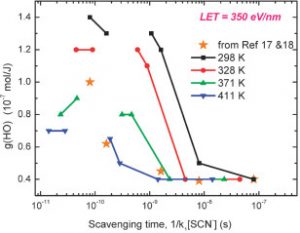Determination of radiolytic yield in a spatio-temporal structure of ionization tracks of high energy heavy ion is the big challenge in liquid water for radiation chemistry modeling of high LET (linear energy transfer) particles especially in a context of nuclear plant and in hadrontherapy. •OH radical is the most oxidant species evolved in radiation chemistry processes immediately following the ionization of water molecule. It is formed within the femtosecond.
Simultaneous effects of LET and temperature, if we consider them in competition, could then reveal the dynamic structure of radicals around the track. To access to these information, the experimental challenge was designing a specific optical flow cell resistant pressure, temperature and letting the ions reaching the solution, knowing these ions have short range in material. These experiments were performed at GANIL in collaboration with CIRIL.

Decay kinetics of ŸOH at short time have been reproduced between 10-11 et 10-9 s at several temperatures by using a fine temporal structure of the ion beam (Ar18+ of 350 eV/nm and O8+ of 65 eV/nm[1]) provided from cyclotron CSS2 and the scavenging method.
The occurrence range of the OH-yield decay is directly in relation with the diameter of the track. So we can conclude that the Ar18+ track is larger and locally denser in ŸOH species than a track of O8+. In both cases, within 25 and 200°C, temperature is accelerating the recombinations but does not interfere with the diffusion process.
For more details, see: Balcerzyk et al., Phys.Chem.Chem.Phys., 2014, 16, 23975
[1] Note that MeV g-rays have an equivalent LET value of 0.3 eV/nm
Contact : Gérard Baldacchino.



